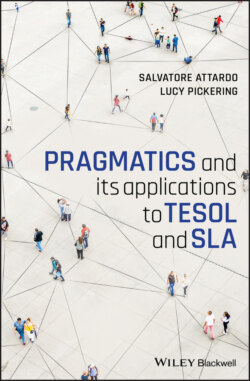Читать книгу Pragmatics and its Applications to TESOL and SLA - Salvatore Attardo - Страница 40
Felicity Conditions: An Analysis of the Speech Act of Promising
ОглавлениеSearle provides a worked out example of the kinds of constitutive rules that define a prototypical, idealized speech act, using the example of “promise.” The analysis is painstaking, but worth considering in detail, if one wants to understand how speech acts actually work. It consists of several felicity conditions, starting with the assumption that the speaker is making the promise to the hearer:
1 Normal input/output conditions. Output is generally speaking, and input is hearing, but appropriate changes can be made for writing, sign language, and so on. This is a very broad category, which includes that both speaker and hearer are capable of and competent to speak the language (e.g., they are not sick, drunk, or otherwise impaired), that they are “seriously” and “literally” engaged in speaking. This stipulation rules out not only “parasitic” (1969, p. 57) uses of language, such as “play acting, teaching a language, reciting poems, practicing pronunciation” (1969, p. 57n1) but also joke telling (1969, p. 57) and nonliteral uses, such as metaphor, irony, and sarcasm.
2 The speaker expresses a proposition p. As we saw, this allows the analysis to decouple the illocutionary force (the promising) from the locutionary aspect (the proposition, or to put it differently, what gets promised in the act of promising). We may add that if the speaker did not express a proposition, the act of promising would be very strange, as witnessed by the following imaginary conversation:(13) A: I promise.B: What?A: Nothing, I am just promising.
3 The promise must regard a future act performed by the speaker. One cannot sincerely promise to do something one has already done, for example. Nor can one promise someone else’s action (although one can promise that one will make someone else do something, but then the promise is that the speaker will coerce the other party). To put it differently, one can only commit one’s will, not someone else’s. Searle stresses too that the future act may be a non-act (as in promising not to do something).
4 The promised act must be viewed positively by the hearer and the speaker must share this belief. If the hearer believes that the promised act is to be viewed negatively, then the promise is not a promise but a threat.
5 The speaker was not going to perform the act independently of the promise. One cannot sincerely promise to go to work the next day, if one was going to do that anyway. In fact, saying I promise to go to work tomorrow presupposes that there is at least a possibility that one may not go to work the next day.
6 The speaker intends to perform the act promised. According to Searle, the distinction between sincere and insincere promises lies in the fact that the speaker does or does not intend to perform the action. Searle also notes that the sincere intention to perform an act presupposes one thinks it is feasible to do so.
7 The speaker intends to incur into the obligation to perform the act promised.
What happens if S produces a speech act but violates one of the aforementioned felicity conditions? We are then faced with a “defective” performance of a speech act (Searle, 1969, p. 54). What does it mean that there was a defective performance? The act was still performed, but one of the felicity conditions is not satisfied. Searle notes that this does not destroy the speech act entirely: if one promises to sing a song, while in fact not intending to do so, they have still performed a speech act of promising, only it was an invalid one. Searle notes that this is directly related to Austin’s concept of infelicity. We will return to this in Chapters 9 and 10.
